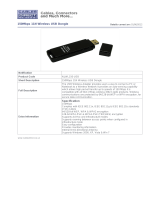
CONTENTS
Chapter 1 Product Overview ................................................................................. 1
1.1 Introduction ............................................................................................................. 1
1.2 Features .................................................................................................................. 1
1.3 LED Status .............................................................................................................. 1
Chapter 2 Connect to a Computer ........................................................................ 2
Chapter 3 Windows ................................................................................................ 3
3.1 Install Driver and Utility ........................................................................................... 3
3.2 Join a Wireless Network .......................................................................................... 6
3.2.1 TP-LINK Utility ............................................................................................ 6
3.2.2 WPS (Wi-Fi Protected Setup) ..................................................................... 7
3.2.3 Windows Wireless Utility .......................................................................... 10
3.3 Management ......................................................................................................... 11
3.3.1 Status ....................................................................................................... 12
3.3.2 Profile ....................................................................................................... 12
3.3.3 Advanced ................................................................................................. 15
3.3.4 SoftAP ...................................................................................................... 15
3.3.5 About ........................................................................................................ 16
3.4 Uninstall Driver and Utility ..................................................................................... 17
Chapter 4 Mac OS X ............................................................................................. 18
4.1 Install Driver and Utility ......................................................................................... 18
4.2 Join a Wireless Network ........................................................................................ 23
4.2.1 TP-LINK Utility .......................................................................................... 24
4.2.2 WPS (Wi-Fi Protected Setup) ................................................................... 25
4.3 Management ......................................................................................................... 27
4.3.1 Link Status ............................................................................................... 27
4.3.2 Profiles ..................................................................................................... 28
4.4 Uninstall Driver and Utility ..................................................................................... 29
Chapter 5 Linux .................................................................................................... 30
Appendix A: Specifications ................................................................................... 31
Appendix B: Glossary ............................................................................................ 32




















